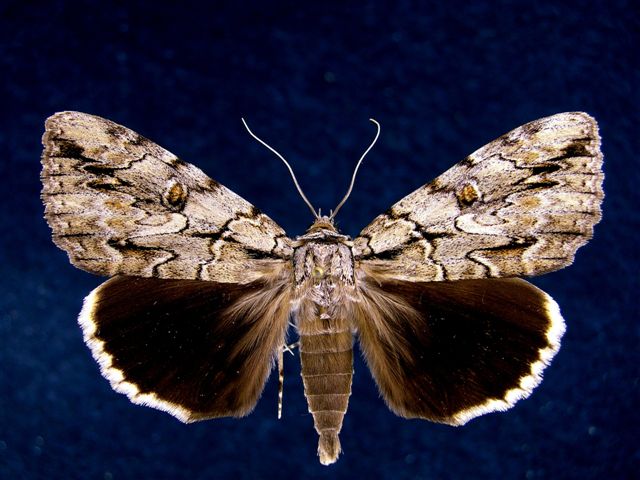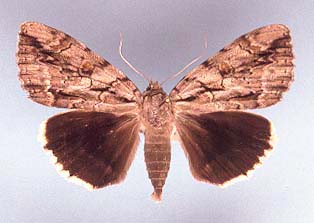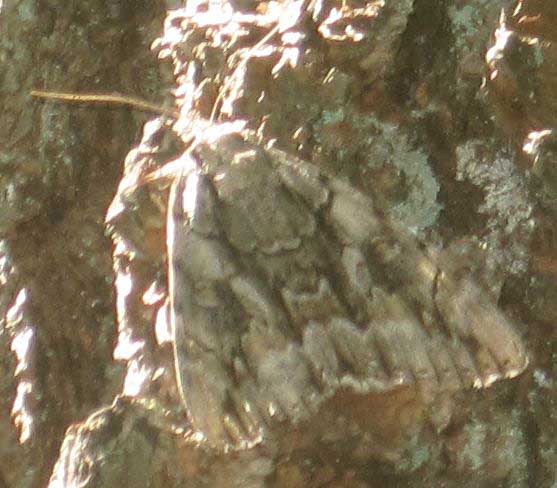Catocala luctuosa
Catocala luctuosa
kah-TOCK-uh-lahmLUKT-choo-oh-suh
Hulst, 1884

Catocala luctuosa, Indiana, wingspan: 70mm, courtesy of
Jim Vargo copyright.
Bristol (Elkhart County), Indiana, August 13, 1995, leg:J.Vargo
This site has been created by
Bill Oehlke at oehlkew@islandtelecom.com
Comments, suggestions and/or additional information are welcomed by Bill.
| TAXONOMY:
Superfamily: Noctuoidea
Family: Noctuidae
Group: Noctuinina
Subfamily: Catocalinae
Genus: Catocala, Schrank, 1802
| |
MIDI MUSIC
"Moon River"
copyright C. Odenkirk
MIDI CITYON.OFF
<bgsound src="moon.mid" LOOP=FOREVER>
|
DISTRIBUTION:
Catocala luctuosa (wingspan: 70 mm)
flies from Indiana to South Carolina,
and probably has a more extensive range.
This species has also been reported in
Arkansas,
Connecticut,
Georgia,
Illinois,
Iowa,
Kansas,
Kentucky,
Maine,
Maryland,
Massachusetts,
Michigan,
Mississippi,
Missouri,
New Hampshire,
New Jersey,
New York,
North Carolina,
Ohio,
Oklahoma,
Pennsylvania,
Rhode Island,
Tennessee,
Virginia,
West Virginia and
Wisconsin
In Canada it has been reported in the province of Ontario.
The light grey (yellowish tint) forewing is clearly marked with a
basal dash that continues with another dash through the antemedial
line, followed by another anal dash almost forming a bar parallel to
the inner margin.
The hindwing fringe is white and is only lightly barred at the veins.
The "teeth" in the forewing postmedial line are elongated and
dark, continuing a dark dar emanating from the outer margin just below the apex.
Catocala luctuosa, courtesy of
James K. Adams. |
 |
The moth is almost identical to Catocala retecta and was at one
time considered a subspecies of retecta. Catocala luctuosa
is a brighter, larger species. The upper half of the basal area,
near the costa, is off-white, almost white. The subreniform spot is
white, elongated and open toward the outer margin. The inner
portion of the reniform spot is brown.
Note the very interesting pattern on the thorax of Jim Vargo's image.

Catocala luctuosa, Amherst, Hampshire County, Massachusetts,
September 2, 2011, courtesy of Joshua S. Rose,
tentative id by Bill Oehlke.
I have entered a tentative id for the specimen, above, largely based on shape of very white subreniform spot,
as well as others markings (arc, dashes, bar), consistent with luctuosa.
FLIGHT TIMES AND PREFERRED FOOD PLANTS:
Catocala luctuosa are on the wing from July to October. Peak
flight is probably in August-September in the northern portions of
range.
The Catocala luctuosa caterpillar probably
feeds on Juglans and Carya species:
pecan and hickories.
Jim Vargo, however, reports that the specimen
at the top of the page was taken in a dry oak habitat near his home
in Mishawaka, Indiana.
ECLOSION:
Adults eclose from pupae at soil surface.
SCENTING AND MATING:
Catocala luctuosa females
emit an airbourne pheromone and males use their antennae to track the
scent plume.
EGGS, CATERPILLARS, COCOONS AND PUPAE:
Eggs are deposited
on tree bark in the fall and hatch the following spring.
Larval Food Plants
Listed below are primary food plant(s) and alternate food plants.
It is hoped that this alphabetical listing followed by the common
name of the foodplant will prove useful. The list is not exhaustive,
although some species seem very host specific.
Experimenting with closely related foodplants is worthwhile.
Carya glabra
Carya illinoinensis.......
Carya ovata
juglans nigra
|
Pignut hickory
Pecan
Shagbark hickory
Black walnut
|
This page is brought to you by Bill Oehlke and the
WLSS. Pages are on space rented from Bizland. If you would like to become a "Patron of the Sphingidae/Catocala Sites",
contact Bill.
Please send sightings/images to Bill. I will do my best to respond to requests for identification help.
Enjoy one of nature's wonderments: Live Saturniidae (Giant Silkmoth) cocoons.

|

To show appreciation for this site, click on the flashing
butterfly to the left, a link
to many worldwide insect sites. |
Return to Canadian Index
Return to Main Index




